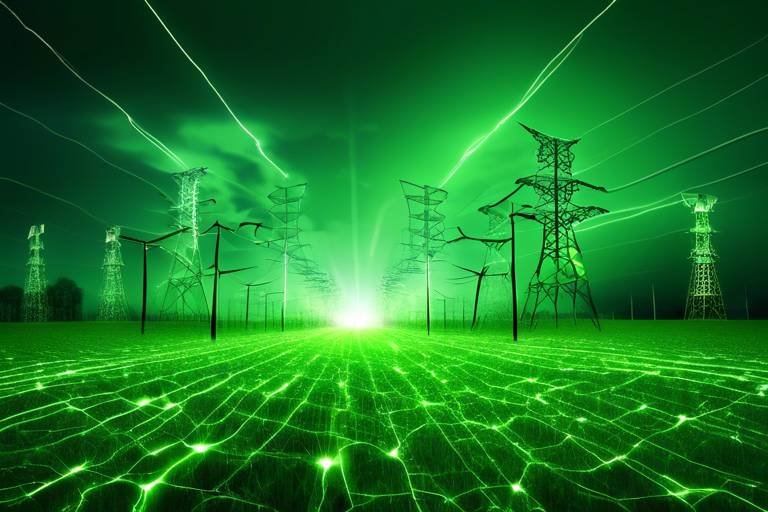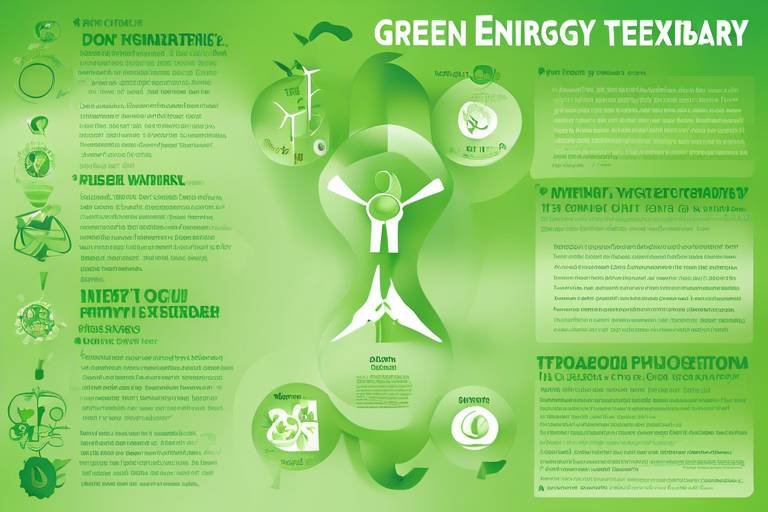The Paradox of Green Energy – A Closer Examination
In a world increasingly aware of the dire consequences of climate change, the shift towards green energy seems like a beacon of hope. However, this transition is not as straightforward as it appears. While renewable energy sources such as solar and wind power promise to reduce our carbon footprint and mitigate environmental degradation, they come with their own set of complexities and contradictions. This article delves into these intricacies, exploring the benefits, challenges, and broader implications of embracing a greener energy future.
The last decade has witnessed a remarkable surge in renewable energy adoption, primarily driven by technological advancements and a growing awareness of climate change. Solar panels now adorn rooftops in cities around the globe, while wind turbines dot the landscapes of rural areas. This transition is not merely a trend; it reflects a fundamental shift in how we perceive energy consumption. As more people understand the urgency of reducing greenhouse gas emissions, the demand for renewable energy sources has skyrocketed. But what exactly has fueled this rise? Factors such as decreasing costs, improved efficiency, and government incentives have all played a crucial role in making renewable energy more accessible and appealing.
On the surface, the environmental benefits of green energy are undeniable. By harnessing natural resources, we can significantly reduce our reliance on fossil fuels, leading to cleaner air and a healthier planet. However, this narrative becomes complicated when we consider the ecological impact of resource extraction necessary for renewable technologies. For instance, the production of solar panels requires materials like silicon and lithium, which involve mining processes that can cause significant environmental harm. This paradox raises important questions: Are we truly helping the environment if the means of producing green technologies contribute to ecological degradation?
Solar energy stands out as one of the most promising renewable sources, capable of powering homes, businesses, and even entire cities. The potential for solar energy is immense, yet its rapid adoption is not without challenges. One major concern is land use; large-scale solar farms can disrupt local ecosystems, leading to habitat loss for various species. Furthermore, the production of solar panels involves energy-intensive processes that can negate some of the environmental benefits they provide. As we look to harness the sun's power, we must also consider the implications of our energy choices.
Recent innovations in photovoltaic technology have made solar energy more efficient and cost-effective than ever before. For instance, new materials and designs are enabling solar panels to capture more sunlight, thereby increasing energy output. These advancements not only make solar energy more viable for consumers but also contribute to a significant reduction in the overall cost of solar installations. As these technologies continue to evolve, the dream of widespread solar adoption may become a reality.
While solar energy offers numerous benefits, the establishment of large solar farms raises critical concerns about land use and biodiversity. The conversion of natural habitats into solar fields can threaten local wildlife and disrupt ecosystems. This challenge calls for a balanced approach to land management, where the need for renewable energy is weighed against the necessity of preserving biodiversity. Innovative solutions, such as dual-use solar farms that integrate agriculture and energy production, may provide a pathway forward that minimizes ecological impact.
Wind energy is another cornerstone of the green energy movement, harnessing the natural power of the breeze to generate electricity. As technology improves, wind farms have become more efficient, capable of producing substantial amounts of power. However, the rise of wind energy is not without its own challenges. The installation of wind turbines can impact local wildlife, particularly birds and bats, which may collide with turbine blades. Additionally, communities may have concerns about noise and aesthetics. These factors highlight the need for careful planning and community engagement in wind energy projects.
One of the most significant hurdles in the transition to green energy is the issue of energy storage. Renewable sources like solar and wind are intermittent, meaning they don't always produce energy when demand is high. This is where battery technologies come into play, serving as a bridge to ensure a steady energy supply. However, current battery technologies face challenges related to efficiency, cost, and environmental impact. As we move towards a greener future, addressing these challenges will be crucial in achieving a sustainable energy system.
Advancements in battery technology are essential for improving energy storage capacity and efficiency. New materials and designs are being developed to create batteries that can store more energy and last longer. This progress is vital for integrating renewable energy into our existing power grids, enabling a smoother transition to a sustainable energy future. As we innovate, the potential for a cleaner, more reliable energy system becomes increasingly attainable.
While the development of new battery technologies is promising, we must also consider the environmental impact of battery disposal. Current recycling methods are often inadequate, leading to hazardous waste and resource depletion. Sustainable recycling processes are essential to minimize the ecological footprint of batteries and ensure that valuable materials are recovered and reused. By prioritizing recycling, we can foster a more sustainable approach to energy storage and consumption.
The role of government policies and economic incentives cannot be overlooked in the quest for green energy. Effective policies can accelerate the adoption of renewable technologies, making them more competitive with fossil fuels. However, transitioning from traditional energy sources presents numerous challenges, including political resistance and economic disparities. To create a sustainable energy future, we must navigate these complexities while fostering a supportive environment for innovation and investment in green technologies.
Financial incentives and subsidies play a pivotal role in promoting renewable energy technologies. By lowering the cost of installation and operation, these incentives can make green energy more accessible to consumers and businesses alike. However, the distribution of these resources must be equitable, ensuring that all communities can benefit from the transition to renewable energy. As we explore the economic implications of green energy, it is essential to consider how policies can foster inclusivity and support for all.
Lastly, the need for equitable access to green energy solutions is paramount. Disparities between developed and developing nations pose significant challenges in achieving global sustainability goals. Addressing these inequalities requires international cooperation and investment in green technologies, ensuring that all countries can transition to renewable energy sources. By working together, we can create a more sustainable and equitable energy landscape for future generations.
- What are the main benefits of green energy? Green energy reduces greenhouse gas emissions, decreases air pollution, and promotes energy independence.
- What challenges does green energy face? Challenges include resource extraction impacts, energy storage limitations, and the need for supportive policies.
- How can we ensure equitable access to green energy? By fostering international cooperation and investing in renewable technologies in developing nations.

The Rise of Renewable Energy
The world is witnessing a remarkable transformation in the energy landscape, with renewable energy sources like solar and wind power taking center stage. This shift is not just a trend; it's a response to the urgent call for action against climate change and environmental degradation. As we become increasingly aware of the dire consequences of fossil fuel consumption, the demand for cleaner, sustainable energy solutions has surged. Technological advancements have played a pivotal role in this revolution, making renewable energy more efficient and accessible than ever before.
Over the past decade, we've seen a significant increase in the adoption of renewable energy technologies. Countries around the globe are investing heavily in infrastructure to harness the power of nature. For instance, solar panels have become a common sight on rooftops, while wind farms are sprouting up in rural areas, transforming the way we think about energy production. According to recent statistics, the global capacity for renewable energy has doubled since 2010, with solar energy alone accounting for a substantial portion of this growth.
But what exactly has driven this rise? Here are a few key factors:
- Technological Advancements: Innovations in solar and wind technologies have dramatically reduced costs and increased efficiency, making renewable energy a viable alternative to fossil fuels.
- Government Policies: Many governments have implemented policies and incentives to promote the use of renewable energy, recognizing its importance in achieving sustainability goals.
- Public Awareness: As climate change becomes a more pressing issue, public awareness and demand for sustainable practices have grown, prompting individuals and businesses to seek greener options.
Moreover, the economic implications of transitioning to renewable energy are profound. Investment in clean energy technologies not only creates jobs but also stimulates economic growth. A report by the International Renewable Energy Agency (IRENA) estimates that the renewable energy sector employed over 11 million people worldwide in 2018, a number that continues to rise as more countries commit to sustainable energy practices.
However, while the rise of renewable energy is undoubtedly a positive development, it's essential to recognize that this transition is not without its challenges. The infrastructure required to support renewable energy generation and distribution is still developing, and there are concerns about the reliability and consistency of energy supply from sources like solar and wind, which are dependent on weather conditions.
In conclusion, the rise of renewable energy represents a significant step forward in our quest for sustainability. While we celebrate the advancements and benefits it brings, we must remain vigilant in addressing the challenges that accompany this transition. The journey towards a greener future is ongoing, and it requires collective effort from governments, businesses, and individuals alike.

Environmental Benefits vs. Resource Extraction
When we think about the shift towards green energy, it's easy to get swept away by the **positive narrative** surrounding renewable resources. After all, who wouldn't want to harness the power of the sun or the wind to combat climate change? However, it's crucial to dig deeper and examine the **complexities** that come with this transition. While renewable energy sources like solar and wind power offer significant environmental benefits, they also demand a considerable amount of resource extraction that can have detrimental effects on our planet.
For instance, the production of solar panels requires **raw materials** such as silicon, silver, and, notably, lithium for energy storage systems. The extraction of these materials often involves **mining practices** that can lead to habitat destruction, soil degradation, and water pollution. The irony is palpable; in our quest to create a more sustainable world, we may inadvertently harm the very ecosystems we aim to protect. This paradox raises an important question: Are we truly trading one set of environmental problems for another?
Moreover, the growing demand for electric vehicles (EVs) and renewable energy technologies has led to a surge in lithium mining, particularly in regions like South America, where the **Lithium Triangle** (comprising Chile, Argentina, and Bolivia) is located. The extraction methods used in these areas can deplete vital water resources, impacting local communities and wildlife. To illustrate this point, consider the following table that compares the environmental impacts of traditional fossil fuel extraction versus lithium mining:
| Extraction Method | Environmental Impact |
|---|---|
| Fossil Fuels | Air and water pollution, habitat destruction, greenhouse gas emissions |
| Lithium Mining | Water depletion, soil degradation, potential for chemical runoff |
While the table highlights the **negative impacts** associated with both extraction methods, it's essential to remember that not all renewable technologies have the same ecological footprint. For instance, wind energy, while generally cleaner, also presents challenges. The construction of wind farms can disrupt local wildlife and ecosystems. Birds and bats are particularly at risk, as they can collide with wind turbine blades, leading to significant mortality rates.
In conclusion, the environmental benefits of green energy cannot be denied; however, we must also acknowledge the **trade-offs** involved. As we continue to innovate and push for a cleaner energy future, it is imperative that we develop strategies to minimize the negative impacts of resource extraction. This includes investing in **sustainable mining practices**, improving recycling technologies for batteries, and exploring alternative materials that reduce our dependence on environmentally harmful extraction processes. Only then can we claim to be on a truly sustainable path.
- What are the main environmental benefits of green energy?
Green energy reduces greenhouse gas emissions, decreases air pollution, and conserves water compared to fossil fuels. - What resources are primarily extracted for renewable energy technologies?
Key resources include lithium, cobalt, silicon, and rare earth metals. - How can we mitigate the environmental impacts of resource extraction?
Implementing sustainable mining practices, investing in recycling, and using alternative materials can help reduce impacts.

Solar Energy: Harnessing the Sun
Solar energy is often hailed as one of the most promising solutions to our energy woes. Imagine harnessing the power of the sun, a massive ball of energy that showers our planet with light and warmth every day. It's like having a giant battery in the sky, ready to fuel our homes, businesses, and even our vehicles. With advancements in technology, solar energy has seen a meteoric rise in adoption, transforming rooftops into power plants and turning vast fields into solar farms. But while the benefits seem overwhelming, there are complexities lurking beneath the surface that we must address.
One of the primary advantages of solar energy is its potential to drastically reduce greenhouse gas emissions. By switching to solar, we can significantly cut down our reliance on fossil fuels, which are notorious for polluting the atmosphere. It's akin to swapping out a gas-guzzling car for a sleek electric vehicle; the difference is not just in performance but in the impact on our planet. However, this transition is not without its challenges. The production of solar panels requires various materials, some of which are sourced through processes that can harm the environment.
For instance, the manufacturing of photovoltaic (PV) panels often involves the extraction of minerals like silicon and rare earth elements. While these materials are essential for creating efficient solar cells, their extraction can lead to land degradation and water pollution. This brings us to a critical question: Can we truly call solar energy sustainable if it comes at the cost of our ecosystems? The answer lies in how we manage and mitigate these impacts.
Recent innovations in photovoltaic technology have made solar energy more efficient and cost-effective than ever before. Traditional silicon-based solar panels have evolved, and new materials such as perovskite are emerging, promising even greater efficiency. These advancements are crucial as they not only enhance energy output but also reduce the overall cost of solar installations. Imagine being able to power your home with fewer panels, saving money while contributing to a greener planet. It’s a win-win!
However, as we embrace solar farms, we must also consider their impact on land use and local biodiversity. Large-scale solar installations can cover vast areas, which may displace natural habitats and disrupt local wildlife. For instance, placing solar panels in previously untouched areas can lead to a loss of biodiversity, much like paving over a lush garden to build a parking lot. To combat this, we need to explore dual-use strategies, where solar panels are installed on rooftops or integrated into existing structures, minimizing the footprint on natural landscapes.
In conclusion, while solar energy presents a bright future for sustainable power, it is essential to navigate its complexities carefully. By focusing on technological advancements and responsible land management, we can harness the sun's energy without compromising our planet's health. As we continue to invest in solar technology, let’s ensure that we are not only capturing sunlight but also protecting the very ecosystems that support us.
- What is solar energy? Solar energy is the energy harnessed from the sun's rays, which can be converted into electricity or heat.
- How do solar panels work? Solar panels contain photovoltaic cells that convert sunlight into electricity through the photovoltaic effect.
- Are solar panels environmentally friendly? While solar panels reduce reliance on fossil fuels, their production can have environmental impacts that need to be managed.
- What are the benefits of solar energy? Solar energy reduces greenhouse gas emissions, lowers electricity bills, and can increase energy independence.
- Can solar energy power my home? Yes, solar energy can be used to power homes, and many people are installing solar panels to reduce their energy costs.

Photovoltaic Technology Advances
In the ever-evolving world of renewable energy, photovoltaic (PV) technology stands out as a beacon of innovation. The recent advances in solar panel efficiency and production processes have propelled solar energy into the mainstream, making it one of the most popular renewable energy sources globally. This surge in popularity is not just a passing trend; it reflects a significant shift in how we harness the power of the sun. But what exactly are the breakthroughs driving this change?
One of the most exciting developments in photovoltaic technology is the advent of monocrystalline solar panels. These panels are made from a single crystal structure, which allows them to achieve higher efficiency rates—often exceeding 20%. This means they can convert a greater portion of sunlight into usable electricity compared to traditional polycrystalline panels. In fact, some of the latest models are pushing efficiency levels even higher, with research labs reporting efficiencies of over 25%. As these technologies become more accessible, consumers are increasingly opting for solar solutions that promise greater energy output from the same amount of space.
Moreover, the integration of bifacial solar panels has also transformed the landscape. These panels can capture sunlight from both sides, effectively doubling their energy output in certain conditions. This innovation not only enhances efficiency but also optimizes land use—allowing solar farms to generate more energy without requiring additional land. Imagine a world where solar panels are not just a rooftop accessory but a dual-purpose solution that maximizes energy production while minimizing land use!
Another notable advancement is the use of thin-film technology. Unlike traditional panels, thin-film solar cells are lightweight and flexible, making them suitable for a variety of applications, from building-integrated photovoltaics to portable solar chargers. This versatility opens up new avenues for solar energy adoption, particularly in urban environments where space is at a premium. With the ability to adapt to different surfaces and structures, thin-film technology could revolutionize how we think about solar energy integration in our daily lives.
As we look towards the future, the development of perovskite solar cells is generating significant buzz in the scientific community. These cells, made from a unique crystal structure, promise to deliver high efficiency at a lower cost than traditional silicon-based panels. Although still in the experimental phase, perovskite cells have shown remarkable potential, with efficiencies approaching 30% in lab settings. If these cells can be successfully commercialized, they could lead to a new era of affordable and efficient solar energy.
In conclusion, the advancements in photovoltaic technology are not just about improving efficiency; they represent a comprehensive shift towards making solar energy more accessible, adaptable, and sustainable. As these technologies continue to develop, we can expect to see solar energy playing an even larger role in our quest for a greener future. The question now is, how quickly can we adapt to these innovations and implement them on a larger scale?
- What is photovoltaic technology? - Photovoltaic technology refers to the method of converting sunlight directly into electricity using solar panels.
- How do monocrystalline panels differ from polycrystalline panels? - Monocrystalline panels are made from a single crystal structure, offering higher efficiency, while polycrystalline panels are made from multiple crystals and generally have lower efficiency.
- What are bifacial solar panels? - Bifacial solar panels can capture sunlight from both sides, increasing energy output without requiring additional land.
- What is thin-film technology? - Thin-film technology involves lightweight and flexible solar cells that can be applied to various surfaces, making them versatile for different applications.
- What are perovskite solar cells? - Perovskite solar cells are a new type of solar cell made from a unique crystal structure, showing potential for high efficiency at lower costs.

Land Use and Biodiversity Concerns
As the demand for renewable energy sources like solar power surges, one cannot overlook the critical associated with large-scale solar farms. While harnessing the sun's energy presents a promising solution to combat climate change, it also raises important questions about the ecological footprint of these installations. Imagine transforming vast stretches of land, previously teeming with life, into expansive solar fields. This transformation can lead to significant disruptions in local ecosystems and habitats.
One major concern is the impact of solar farms on biodiversity. When land is cleared for solar panels, native flora and fauna may be displaced, leading to a decline in species that rely on those habitats. For instance, consider the plight of pollinators such as bees and butterflies, which are essential for the health of ecosystems and agriculture alike. The loss of their habitats can have cascading effects, not just on the insects themselves but on the plants and animals that depend on them.
Moreover, the scale of these solar installations can pose challenges for land management. Depending on the region, solar farms may require substantial amounts of land, leading to conflicts over land use priorities. In areas where agricultural land is converted to solar farms, farmers may face economic pressures, and food production could potentially be compromised. It's a classic case of balancing the urgent need for clean energy with the equally pressing need to maintain food security and protect our natural heritage.
To mitigate these concerns, it is crucial to adopt strategic planning and site selection for solar projects. This involves identifying locations that minimize ecological impact, such as brownfields or previously disturbed lands, rather than pristine habitats. Additionally, integrating solar energy production with agricultural practices—known as agrivoltaics—can help maximize land use efficiency while preserving biodiversity. This innovative approach allows crops to thrive under solar panels, creating a win-win situation for energy production and food supply.
Ultimately, as we push forward in the quest for sustainable energy, we must remain vigilant about the interconnectedness of our ecosystems. The conversation surrounding solar energy should not solely focus on its benefits; it must also encompass the potential trade-offs involved. By addressing land use and biodiversity concerns proactively, we can strive for a future where renewable energy coexists harmoniously with the natural world.
- What are the main environmental impacts of solar farms?
Solar farms can lead to habitat destruction, loss of biodiversity, and changes in land use, affecting local ecosystems. - How can we mitigate the impact of solar energy on biodiversity?
Strategic site selection, using previously disturbed lands, and integrating solar panels with agricultural practices can help reduce ecological impacts. - What is agrivoltaics?
Agrivoltaics is a practice that combines agriculture and solar energy production, allowing crops to grow under solar panels, optimizing land use. - Are there regulations in place to protect wildlife near solar farms?
Yes, many regions have regulations that require environmental assessments before solar projects are approved to minimize impacts on wildlife.

Wind Energy: The Power of the Breeze
Wind energy has emerged as a formidable player in the renewable energy sector, harnessing the natural power of the breeze to generate electricity. This clean energy source has seen exponential growth over the past decade, driven by technological advancements and a global push towards sustainable energy solutions. But what makes wind energy so appealing? For starters, it’s abundant, renewable, and produces minimal greenhouse gas emissions compared to fossil fuels. Imagine transforming the very air we breathe into a source of power—it's like catching a wave at the beach, but instead, you're capturing the wind!
However, the rise of wind energy isn't without its challenges. As we install more wind turbines across landscapes, we need to consider their impact on local wildlife and communities. For instance, the placement of wind farms can disrupt migration patterns of birds and bats. Additionally, the visual and noise pollution generated by these towering structures can be a source of contention among local residents. It’s a bit like building a giant roller coaster in your backyard; it might be thrilling for some, but for others, it can be quite an eyesore!
To better understand the impact of wind energy, let’s take a look at some key statistics:
| Year | Global Wind Energy Capacity (GW) | Annual Growth Rate (%) |
|---|---|---|
| 2010 | 199 | 22% |
| 2015 | 432 | 20% |
| 2020 | 743 | 10% |
| 2023 (Projected) | 1,000 | 15% |
This table illustrates the remarkable growth of wind energy capacity worldwide, showcasing its potential to contribute significantly to our energy mix. As we move towards a greener future, the integration of wind energy into our existing power grids becomes increasingly vital.
Moreover, the technology behind wind turbines has evolved dramatically. Modern turbines are not only taller and more efficient but also designed to minimize their ecological footprint. With innovations such as larger rotor blades and advanced materials, today's wind energy systems can capture more wind and convert it into electricity with greater efficiency. It’s akin to upgrading from a bicycle to a high-speed motorcycle; the performance leap is significant!
In conclusion, while wind energy presents a promising avenue for sustainable power generation, we must balance its benefits with the potential ecological consequences. As we embrace this powerful resource, it's essential to engage in thoughtful planning and community dialogue. After all, the winds of change are blowing, and how we harness that power will shape our environmental future.
- What are the main advantages of wind energy? Wind energy is renewable, reduces greenhouse gas emissions, and has low operating costs once turbines are installed.
- How do wind turbines affect wildlife? Wind turbines can pose risks to birds and bats, particularly if not sited carefully. However, advancements in technology aim to mitigate these impacts.
- Can wind energy provide enough power for large cities? Yes, with sufficient wind farms and energy storage solutions, wind energy can supply a significant portion of a city's electricity needs.
- What is the future of wind energy? The future looks bright for wind energy, with continued technological advancements and increasing investments aimed at expanding capacity and efficiency.

Energy Storage Challenges
As we dive deeper into the realm of green energy, one of the most pressing issues that come to light is the challenge of energy storage. Imagine a world where we harness the sun's rays and the winds' whispers to generate power, but then struggle to keep that energy for when we need it most. This is the paradox we face in the transition to renewable energy sources. The sun doesn't always shine, and the wind doesn't always blow, leading to a critical need for effective storage solutions to ensure a steady energy supply.
Currently, most renewable energy systems generate power intermittently, which means we need robust energy storage technologies to bridge the gap between energy generation and consumption. The most common solution today is the use of batteries, but these come with their own set of challenges. For instance, traditional lithium-ion batteries, while efficient, are reliant on materials that pose significant environmental and ethical concerns. The extraction of lithium and cobalt, essential components in these batteries, can lead to ecological degradation and human rights violations.
Furthermore, the lifespan of these batteries is limited, raising questions about what happens to them once they reach the end of their life cycle. Without effective recycling methods, we risk creating a new kind of waste problem, one that could undermine the very sustainability goals we aim to achieve with green energy. In fact, the environmental impact of battery disposal is a growing concern that cannot be overlooked.
To illustrate the current state of battery technology and its challenges, consider the following table:
| Battery Type | Advantages | Challenges |
|---|---|---|
| Lithium-Ion | High energy density, widely used | Resource extraction issues, limited lifespan |
| Lead-Acid | Cost-effective, mature technology | Heavy, lower energy density, environmental concerns |
| Solid-State | Higher safety, better energy density | Still in development, high production costs |
As we explore innovative battery technologies, we must also consider how to create a sustainable recycling ecosystem for these energy storage systems. The development of new methods to recycle and repurpose old batteries will be crucial in addressing both the waste management issue and the demand for raw materials. This will not only mitigate environmental impact but also help in establishing a circular economy that aligns with the principles of sustainability.
In summary, while the promise of green energy is bright, the path to achieving it is fraught with challenges, particularly in the realm of energy storage. As we continue to innovate and improve our technologies, it is essential that we remain vigilant in addressing the environmental and ethical implications of our choices. Only then can we hope to create a truly sustainable energy future.
- What are the main challenges of energy storage in renewable energy systems? The main challenges include the intermittent nature of renewable energy generation, limited battery lifespan, resource extraction issues, and the need for effective recycling methods.
- Why are lithium-ion batteries a concern for the environment? Lithium-ion batteries require materials like lithium and cobalt, which can be sourced through environmentally damaging practices and may involve human rights violations.
- What innovations are being made in battery technology? Innovations include the development of solid-state batteries, which promise higher safety and energy density, as well as advancements in recycling technologies.

Battery Technologies and Innovations
In the ever-evolving landscape of green energy, battery technologies stand out as a crucial component in revolutionizing how we harness and store renewable energy. As we pivot towards a more sustainable future, the demand for efficient and reliable energy storage solutions has never been greater. With advancements in battery technology, we are not just keeping pace with the growing energy needs; we are also setting the stage for a cleaner, greener tomorrow.
One of the most exciting developments in this field is the emergence of solid-state batteries. Unlike traditional lithium-ion batteries that use liquid electrolytes, solid-state batteries employ solid electrolytes, which can significantly enhance energy density and safety. This innovation is like upgrading from a bicycle to a high-speed train; the potential for faster charging and longer-lasting power is immense. Solid-state batteries promise to deliver more energy in a smaller footprint, making them ideal for everything from electric vehicles to portable electronics.
Another noteworthy innovation is the rise of lithium-sulfur batteries. These batteries have the potential to outperform conventional lithium-ion batteries by offering higher energy capacity at a lower cost. Imagine being able to power your electric vehicle for longer distances without needing a recharge every few hours. This technology not only enhances performance but also reduces the reliance on scarce materials, making it a more sustainable option.
However, it’s not just about the chemistry of the batteries; the manufacturing process is also undergoing significant innovation. Companies are investing in advanced manufacturing techniques that allow for quicker production times and reduced waste. For instance, the use of 3D printing in battery production is gaining traction, enabling manufacturers to create complex structures that enhance battery performance while minimizing material usage. This shift is akin to moving from traditional cooking methods to a microwave—it's faster, more efficient, and often results in better outcomes.
Moreover, the integration of artificial intelligence (AI) in battery management systems is paving the way for smarter energy storage solutions. AI algorithms can optimize charging cycles and predict battery lifespan, ensuring that energy is used efficiently and sustainably. This intelligent approach to battery management is like having a personal assistant who not only helps you manage your schedule but also ensures that everything runs smoothly without any hiccups.
Yet, despite these promising advancements, challenges remain. The lifecycle of batteries, from production to disposal, raises significant environmental concerns. As we innovate, we must also consider how to recycle these batteries effectively. The development of sustainable recycling methods is crucial for minimizing waste and ensuring that valuable materials are recovered and reused. The push for a circular economy in battery production is not just a trend; it’s a necessity for maintaining the balance between innovation and sustainability.
In conclusion, the future of battery technologies is bright, filled with innovations that promise to enhance energy storage capabilities. As we continue to explore these advancements, we must keep our focus on sustainability and responsible resource management. By doing so, we can ensure that the leap towards renewable energy is not just a temporary fix but a lasting solution for generations to come.
- What are solid-state batteries? Solid-state batteries use solid electrolytes instead of liquid ones, providing greater energy density and safety.
- How do lithium-sulfur batteries differ from lithium-ion batteries? Lithium-sulfur batteries offer higher energy capacity and lower costs, making them a more sustainable option.
- What role does AI play in battery management? AI optimizes charging cycles and predicts battery lifespan, enhancing efficiency and sustainability.
- Why is battery recycling important? Recycling minimizes waste and recovers valuable materials, contributing to a circular economy.

Recycling and Sustainability Issues
The transition to green energy, while promising, brings along a host of that need to be addressed. As we ramp up the production of renewable energy technologies, particularly batteries for solar and wind energy, we must confront the reality of what happens when these products reach the end of their life cycle. It’s not just about harnessing clean energy; it’s also about ensuring that we are not creating a new form of environmental pollution through improper disposal.
One of the most pressing concerns is the environmental impact of battery disposal. Traditional methods of disposing of batteries can lead to hazardous materials leaking into the environment, contaminating soil and water sources. This is particularly alarming considering that batteries often contain toxic substances like lead, cadmium, and lithium. Therefore, it is imperative that we develop effective recycling methods to mitigate these risks.
Currently, the recycling rate for lithium-ion batteries, which power most renewable energy systems, is alarmingly low. Estimates suggest that less than 5% of these batteries are recycled globally. This is a stark contrast to the recycling rates of other materials like aluminum or glass, which can exceed 70%. The question arises: how can we improve these rates? The answer lies in innovation and infrastructure.
To tackle the recycling issue, we need to invest in advanced recycling technologies that can efficiently reclaim valuable materials from used batteries. For instance, companies are developing processes that can recover up to 95% of lithium and other critical minerals from spent batteries. This not only reduces waste but also lessens the need for new resource extraction, which can be environmentally damaging.
Moreover, public awareness and education play a crucial role in enhancing recycling efforts. If consumers are informed about the importance of recycling batteries and the potential impacts of improper disposal, they are more likely to participate in recycling programs. Community initiatives, such as battery drop-off locations and educational campaigns, can significantly increase recycling rates.
In addition to recycling, we must also consider the sustainability of the entire lifecycle of renewable energy technologies. This involves examining the materials used in production, the energy consumed during manufacturing, and the end-of-life disposal methods. For example, the mining of lithium can have significant environmental impacts, including habitat destruction and water depletion. Thus, integrating sustainability into every step of the production process is essential.
| Issue | Impact | Solution |
|---|---|---|
| Battery Disposal | Soil and water contamination | Improved recycling methods |
| Low Recycling Rates | Increased waste and resource extraction | Public awareness campaigns |
| Material Sourcing | Environmental degradation | Sustainable sourcing practices |
In conclusion, while the shift to green energy is a step in the right direction, it is crucial that we do not overlook the sustainability challenges associated with it. By focusing on recycling, increasing public awareness, and implementing sustainable practices throughout the lifecycle of renewable energy technologies, we can ensure that our pursuit of a cleaner planet does not come at the expense of our environment.
- What happens to batteries when they are disposed of improperly? Improper disposal can lead to toxic materials leaking into the environment, contaminating soil and water.
- How can we improve battery recycling rates? By investing in advanced recycling technologies and increasing public awareness about the importance of recycling.
- What are the environmental impacts of lithium mining? Lithium mining can lead to habitat destruction, water depletion, and pollution.

Policy and Economic Implications
The transition to green energy isn't just about harnessing the power of the sun or the wind; it also involves a complex web of policies and economic incentives that can either propel or hinder progress. Governments around the globe are recognizing the urgent need to address climate change, and many are implementing policies aimed at reducing carbon emissions and promoting renewable energy sources. But what does this really mean for the average person? And how do these policies affect the broader economy?
One of the most significant ways governments can encourage the adoption of renewable energy technologies is through subsidies. These financial incentives can lower the cost of solar panels, wind turbines, and other green technologies, making them more accessible to consumers and businesses alike. For example, in the United States, the federal solar tax credit allows homeowners to deduct a substantial percentage of the cost of solar panel installation from their federal taxes. This not only makes solar energy more affordable but also stimulates job creation in the renewable energy sector.
However, while subsidies can accelerate the adoption of green technologies, they also raise questions about market dynamics. When the government intervenes with financial incentives, it can distort the natural competition in the energy market. This can lead to a situation where certain technologies become favored over others, potentially stifling innovation. Moreover, the reliance on subsidies can create a dependency that might be difficult to sustain in the long run, especially if political winds shift.
Another critical aspect of the policy landscape is the concept of global energy equity. As the world shifts towards renewable energy, it's essential to ensure that access to these technologies is equitable. Developing nations often lack the financial resources and infrastructure to invest in green technologies, leaving them at a disadvantage. This disparity raises ethical questions about our collective responsibility to support global energy transitions. Should wealthier nations provide assistance to help developing countries leapfrog to cleaner energy solutions? The answer is not straightforward, but it's a conversation that needs to happen.
To better illustrate the various policy implications, consider the following table that outlines some key government initiatives and their impacts:
| Policy Initiative | Description | Impact |
|---|---|---|
| Feed-in Tariffs | Guaranteed payments to renewable energy producers for the energy they generate. | Encourages investment in renewable energy projects. |
| Renewable Portfolio Standards | Mandates that a certain percentage of energy must come from renewable sources. | Increases the market for renewable energy. |
| Carbon Pricing | Taxes on carbon emissions to encourage companies to reduce their carbon footprint. | Creates a financial incentive to transition to cleaner energy sources. |
In conclusion, the policy and economic implications of transitioning to green energy are vast and multifaceted. While there are significant benefits to be gained, such as job creation and reduced emissions, there are also challenges that must be navigated carefully. As we continue to explore these opportunities, it’s crucial for policymakers to strike a balance between fostering innovation and ensuring that all communities have access to the benefits of renewable energy.
- What are the main benefits of government subsidies for renewable energy? Government subsidies can lower costs for consumers, stimulate job growth, and accelerate the adoption of clean technologies.
- How do policies affect the energy market? Policies can create incentives or disincentives for certain technologies, potentially distorting natural market competition.
- What is global energy equity? Global energy equity refers to the fair distribution of renewable energy technologies and resources across different nations, especially between developed and developing countries.

Subsidies and Incentives
In the ever-evolving landscape of green energy, subsidies and incentives play a pivotal role in shaping the future of renewable technologies. These financial supports are designed to encourage both consumers and businesses to adopt cleaner energy solutions. Think of them as the gentle nudge that pushes us toward a more sustainable future. Governments around the world recognize that transitioning from fossil fuels to renewable sources is not just a trend, but a necessity for our planet’s health.
For instance, many countries offer tax credits for solar panel installations, which can significantly reduce the upfront costs for homeowners. This is crucial because, let’s face it, the initial investment in renewable energy can be daunting. By lowering these financial barriers, subsidies make it easier for individuals and businesses to make the switch. But it isn’t just about solar; wind energy projects often benefit from similar financial incentives that can cover a portion of installation costs, making them more appealing to investors.
Moreover, these incentives can extend beyond direct financial support. They often come in the form of grants, low-interest loans, or feed-in tariffs, which guarantee a fixed payment for energy produced from renewable sources. This creates a stable economic environment that encourages innovation and investment in green technologies. Just imagine a farmer who can sell excess power generated from wind turbines back to the grid—this not only helps the farmer financially but also contributes to a more sustainable energy landscape.
However, while subsidies and incentives can accelerate the adoption of renewable energy, they are not without their challenges. For one, the distribution of these incentives can sometimes favor larger corporations over small businesses or individual homeowners. This disparity raises questions about global energy equity and whether everyone has fair access to the benefits of green energy. The challenge lies in crafting policies that ensure equitable access while still promoting innovation and growth in the renewable sector.
To further illustrate the impact of subsidies, let’s take a look at a comparative table of renewable energy incentives in various countries:
| Country | Type of Incentive | Details |
|---|---|---|
| United States | Tax Credit | Investment Tax Credit (ITC) for solar installations. |
| Germany | Feed-in Tariff | Guaranteed payments for renewable energy fed into the grid. |
| China | Subsidy | Direct subsidies for solar panel manufacturers. |
| India | Grants | Financial support for solar projects in rural areas. |
As we can see from this table, different countries adopt various approaches to incentivize green energy, each tailored to their unique economic and environmental contexts. The key takeaway here is that while subsidies and incentives are essential for promoting renewable energy, they must be designed thoughtfully to ensure they benefit a wide range of stakeholders.
In conclusion, understanding the role of subsidies and incentives in the green energy sector is crucial for anyone looking to navigate this complex landscape. They are not just financial tools; they are the lifeblood of innovation and sustainability, paving the way for a cleaner, greener future. So, as we continue to explore the paradox of green energy, let’s keep our eyes on how these incentives evolve and shape the world around us.
- What are renewable energy subsidies? Subsidies are financial aids provided by the government to promote the adoption of renewable energy technologies.
- How do incentives affect the cost of renewable energy? Incentives can significantly lower the initial investment required for renewable energy projects, making them more accessible.
- Are there any downsides to subsidies? Yes, sometimes subsidies can disproportionately favor larger corporations, creating inequities in access to renewable energy technologies.
- Can subsidies lead to innovation? Absolutely! By reducing financial risks, subsidies encourage investment in research and development of new technologies.

Global Energy Equity
The concept of is becoming increasingly crucial as the world shifts towards renewable energy solutions. It raises an important question: how can we ensure that everyone, regardless of where they live, has access to clean and sustainable energy? While developed nations have made significant strides in adopting green technologies, many developing countries still struggle with energy poverty. This disparity highlights the need for a more equitable distribution of energy resources and technologies.
Access to renewable energy is not just a matter of technological availability; it's also deeply intertwined with economic and political factors. For instance, countries with abundant natural resources, like sunlight and wind, have the potential to harness these energies for their own use and export. However, they often lack the infrastructure or financial backing to develop these resources effectively. This is where international cooperation and investment can play a transformative role.
Consider the following points when discussing global energy equity:
- Investment in Infrastructure: Developing nations need financial support to build the necessary infrastructure for renewable energy. This includes everything from solar farms to wind turbines and the grids that connect them to consumers.
- Technology Transfer: Advanced technologies for renewable energy should be shared with developing nations. This not only promotes energy equity but also fosters innovation and local job creation.
- Policy Frameworks: Governments must implement policies that encourage the adoption of green technologies. This could involve subsidies for renewable energy projects or tax incentives for companies investing in sustainable practices.
Moreover, the fight for global energy equity is also a fight against climate change. When developing countries can access and utilize renewable energy, they can significantly reduce their carbon footprints. This is a win-win situation: it helps the planet while also providing these nations with the energy they need to grow economically.
However, achieving energy equity is not without its challenges. Political instability, lack of education about renewable technologies, and economic constraints can hinder progress. It’s essential for international organizations, governments, and private sectors to collaborate and create comprehensive strategies that address these barriers.
In summary, global energy equity is about more than just providing access to renewable energy; it's about ensuring that all nations can participate in and benefit from the green energy revolution. By addressing the disparities in energy access, we can create a more sustainable and equitable world for everyone.
Frequently Asked Questions
1. What is global energy equity?
Global energy equity refers to the fair distribution of energy resources and access to renewable energy technologies across different countries, ensuring that all populations, especially in developing nations, have the ability to harness clean energy.
2. Why is energy equity important?
Energy equity is crucial for addressing energy poverty and ensuring that all nations can participate in the global transition to renewable energy, which is essential for combating climate change and promoting sustainable development.
3. How can developed nations help achieve energy equity?
Developed nations can assist by investing in renewable energy infrastructure in developing countries, sharing technology, and creating favorable policy frameworks that encourage sustainable energy practices.
Frequently Asked Questions
-
What are the main benefits of green energy?
Green energy offers a plethora of benefits, including reduced greenhouse gas emissions, lower air pollution, and decreased reliance on fossil fuels. By harnessing renewable sources like solar and wind, we can create a more sustainable energy future, which not only helps combat climate change but also promotes energy independence.
-
Are there any downsides to renewable energy sources?
Absolutely! While green energy is generally better for the environment, the extraction of materials needed for technologies like batteries can have significant ecological impacts. For instance, lithium mining can disrupt ecosystems and water supplies. It's essential to balance the benefits of renewable energy with the environmental costs associated with its production.
-
How does solar energy impact land use and biodiversity?
Large-scale solar farms can lead to land use changes that may threaten local wildlife and disrupt natural habitats. While solar energy is a clean power source, it's crucial to consider how these installations affect biodiversity. Thoughtful land management practices can help mitigate these impacts, ensuring that we harness solar power without compromising our ecosystems.
-
What innovations are being made in battery technology?
Recent advancements in battery technology focus on increasing energy storage capacity and efficiency, which are vital for integrating renewable energy into our grid. Innovations like solid-state batteries and new recycling methods are paving the way for a more sustainable energy future, making it easier to store and use renewable energy when it's needed most.
-
How important is recycling for battery sustainability?
Recycling is critical for sustainability in the realm of battery technology. As the demand for batteries increases, so does the need for effective recycling methods to minimize waste and recover valuable materials. Developing efficient recycling processes can help reduce the environmental impact of battery disposal and ensure that we can keep up with the growing need for energy storage.
-
What role do government policies play in promoting green energy?
Government policies are pivotal in accelerating the transition to green energy. Subsidies, tax incentives, and regulations can encourage both consumers and businesses to adopt renewable technologies. By creating a favorable economic environment for green energy, governments can help drive innovation and investment in sustainable energy solutions.
-
How can we ensure global energy equity in the transition to green energy?
Ensuring global energy equity involves addressing the disparities between developed and developing nations in accessing green energy solutions. This can be achieved through international cooperation, funding, and technology transfer, enabling all countries to benefit from renewable energy advancements and contribute to a sustainable future.



















